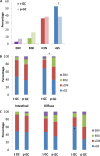Molecular characterization of gastric adenocarcinoma diagnosed in patients previously treated for Hodgkin lymphoma or testicular cancer
- PMID: 35877698
- PMCID: PMC9312836
- DOI: 10.1371/journal.pone.0270591
Molecular characterization of gastric adenocarcinoma diagnosed in patients previously treated for Hodgkin lymphoma or testicular cancer
Abstract
Introduction: The risk of developing gastric cancer is increased in patients treated with radiotherapy for Hodgkin lymphoma (HL) or testicular cancer (TC). This study aims to assess if gastric adenocarcinoma after treatment for HL/TC (t-GC) is molecularly different from gastric adenocarcinoma in the general population.
Methods: Patients were diagnosed with t-GC ≥5 years after treatment for HL/TC. Four molecular subtypes were identified using immunohistochemical and molecular analyses: Epstein-Barr virus (EBV), mismatch repair (MMR) deficiency or microsatellite instability (MSI), aberrant p53 staining as surrogate for chromosomal instability (sCIN), and a surrogate for genomic stability (sGS) without these aberrations. Results were compared with gastric cancer in the general population (p-GC) described in literature.
Results: Molecular subtyping of 90 t-GCs resulted in 3% EBV, 8% MSI, 36% sCIN and 53% sGS. 3/6 of MSI t-GCs had MLH1 promoter methylation and 2/6 were explained by double somatic mutations in MMR genes. T-GCs were more frequently sGS than p-GCs (53% vs. 38%, p = 0.04). T-GC was more frequently sGS in HL/TC patients diagnosed before 1990, than after 1990 (63% vs. 38%, p = 0.03). T-GCs located in the antrum, an area that receives high irradiation doses, were more frequently sGS (61% vs. 28% in p-GCs, p = 0.02).
Conclusion: Our results demonstrate that t-GCs are more frequently of the sGS subtype than p-GCs. An association of t-GC of the sGS subtype with prior anticancer treatment is suggested by the high frequency in HL/TC patients who were treated before 1990, a time period in which HL/TC treatments were more extensive.
Conflict of interest statement
The authors have declared no conflict of interest.
Figures


References
Publication types
MeSH terms
Supplementary concepts
LinkOut - more resources
Full Text Sources
Medical
Research Materials
Miscellaneous

